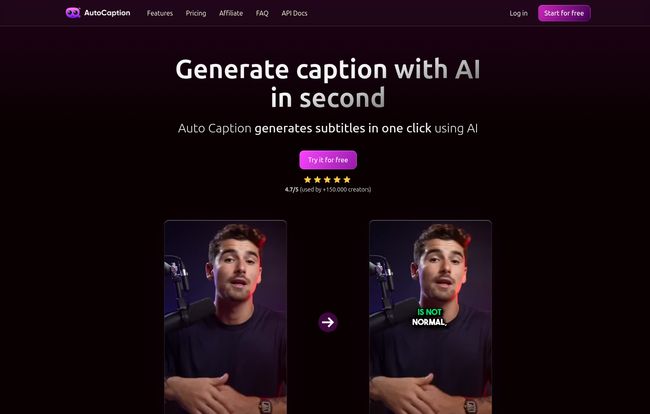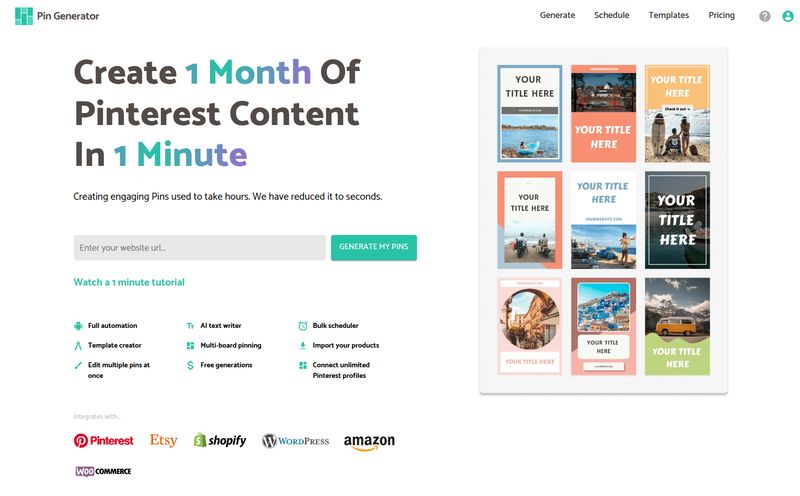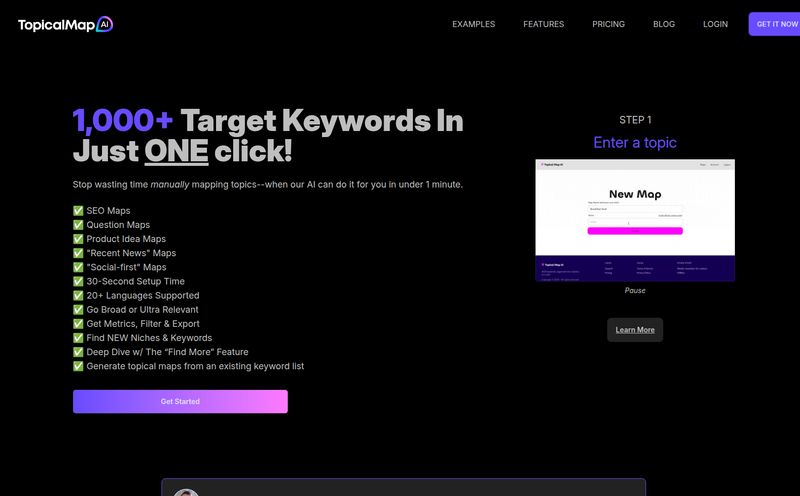If you’re a content creator, a social media manager, or anyone who’s ever had to make a video for the internet, you know the pain. You spend hours shooting and editing the perfect video. You’ve got the lighting just right, the cuts are snappy, the audio is crisp. You’re ready to post. And then it hits you. The final boss of video creation: the captions.
For years, this has been my personal nightmare. Manually typing out every word. Timing it perfectly. Trying to make it look… not terrible. It’s a soul-crushing, time-devouring task that makes you question all your life choices. I've tried everything—clunky desktop software, hiring someone on Fiverr, even just giving up and hoping people watch with the sound on (they don't, by the way. Studies show a huge chunk of social videos are watched on mute).
So when the wave of AI captioning tools started crashing onto the scene, I was skeptical but hopeful. I've tested a bunch, and today I’m looking at one that's been getting some buzz: AutoCaption. It promises to generate subtitles in one click with fancy animations and emojis. But is it another overhyped gadget or a genuine lifesaver? Let's get into it.

Visit AutoCaption
First Off, What Is AutoCaption, Anyway?
Let's not overcomplicate it. AutoCaption is an AI-powered tool that listens to the audio in your video and automatically writes out the subtitles for you. But its main hook isn't just transcription. It’s built from the ground up for the aesthetic of modern social media. Think engaging, animated captions like you see on top-tier TikTok and Instagram Reels—the kind that keep people's eyeballs glued to the screen.
It's not trying to be a full-blown video editor like Adobe Premiere or DaVinci Resolve. It’s a specialist. A tool designed to do one specific, annoying job really, really well. And for the over-caffeinated creator trying to stay on top of the content treadmill, that focus is pretty refreshing.
The Features That Actually Matter
A feature list is just a list. What matters is how it works in the real world. After playing around with it, here’s what stood out to me.
The AI Transcription: How Accurate Is It, Really?
This is the make-or-break feature. If the AI is dumb, the whole tool is useless. I fed AutoCaption a few different videos—one with clear podcast-quality audio, and another I shot on my phone with some background noise. The results were... pretty impressive. For the clear audio, it was nearly 99% accurate. I had to make a few tiny tweaks for punctuation and a proper noun here and there, but that’s it.
Now, for the phone audio, it struggled a bit more, which is expected. Here’s the golden rule of any transcription service: garbage in, garbage out. If your audio is a muffled mess recorded next to a construction site, no AI on earth is going to give you perfect captions. But for decent-quality audio? AutoCaption is solid. Plus, with support for over 100 languages, it’s a great tool if you're trying to reach a global audience. A huge plus in my book.
Beyond Just Words: The Customization Is Where It Shines
Here’s what I genuinely love. The customization. Getting the words right is one thing, but making them look good is the secret sauce for social media engagement. AutoCaption gets this. You can easily change fonts, colors, and animations to match your brand style. Want that flashy, word-by-word karaoke-style animation? Done in one click. Want to add an animated 🔥 or 😂 emoji when you say something exciting? Easy.
This is more than just a gimmick. Consistent, stylish captions make your content look more professional and can seriously boost watch time. The ability to create and save your own personal templates means you can get your branding spot-on in every video without starting from scratch. That's a huge time-saver.
My Honest Take: The Good, The Bad, and The Pricey
No tool is perfect. So let's break down my real feelings on AutoCaption. It’s not a one-size-fits-all solution, and that's okay.
The biggest advantage is the sheer speed. A task that used to take me 30-45 minutes per Reel now takes about five. And most of that is just me being a perfectionist and tweaking a word or two. It’s easy to use, the interface is clean, and the learning curve is basically a flat line. For its core purpose—creating stylish captions for short-form video—it absolutely delivers.
However, there are limitations. The main one is the video duration limits on the plans. The Starter plan caps you at 2 minutes, and even the Pro plan tops out at 7 minutes. This means AutoCaption is not the tool for your long-form YouTube essays or in-depth interviews. It's purpose-built for the fast-paced world of Shorts, Reels, and TikToks. And as I mentioned, the accuracy is totally dependent on your sound quality, so audiophiles will have a much better time.
Let's Talk Money: A Breakdown of AutoCaption's Pricing
Ah, the all-important question: how much does it cost? AutoCaption uses a subscription model with a few different tiers. They offer monthly and annual billing, with the annual plans giving you a nice discount (around 25%). I’ll focus on the annual prices since they're the most attractive.
| Plan | Annual Price | Key Limits | Best For |
|---|---|---|---|
| Starter | $14 /month | 100 videos/mo, 2 min max duration | The beginner or personal user just getting their feet wet. |
| Expert (Popular) | $19 /month | 215 videos/mo, 4 min max duration, Custom fonts | Most serious content creators and influencers. This is the sweet spot. |
| Pro | $29 /month | 500 videos/mo, 7 min max duration, Personal support | Freelancers, small businesses, or agencies managing multiple accounts. |
My take? The Expert plan is the best value for anyone who is serious about creating video content regularly. The bump in video duration and the addition of custom fonts and templates make it worth the extra few bucks a month over the Starter plan. The Pro plan is likely overkill unless you are a high-volume agency.
How Does It Compare to Other Tools?
The AI tool space is crowded. You've got giants like Descript, which is more of an all-in-one podcast and video editor. You have free options like CapCut's built-in captioning, which is okay but fairly basic. Then you have direct competitors like Submagic.
Where does AutoCaption fit in? In my opinion, it sits in a nice little niche. It’s more powerful and stylish than the free options, but less complex and overwhelming than a full-blown editor like Descript. It’s for the creator who says, “I just want awesome-looking, accurate captions for my social videos, and I want it done five minutes ago.” If that’s you, it’s a strong contender.
Frequently Asked Questions
- Is there a free trial for AutoCaption?
- The site has a "Start for free" button, which typically means you can try out the service, likely with some limitations (like a watermark or limited features), before committing to a paid plan.
- How accurate are the AI captions, really?
- They're very accurate with clear audio—I'd say 95-99%. The quality drops if you have a lot of background noise, music, or mumbling. It's best to use it with a clean audio source.
- Can I use my own brand fonts and colors?
- Yes, you can! But this feature is reserved for the Expert and Pro plans. The Starter plan comes with a selection of ready-to-use templates and fonts.
- Is AutoCaption good for long YouTube videos?
- Honestly, no. The maximum video duration is 7 minutes on the most expensive plan. It's specifically designed for short-form content like Reels, TikToks, and Shorts.
- What happens if I go over my monthly video limit?
- You'll likely need to upgrade your plan or wait until the next monthly cycle begins. It’s designed to handle a specific volume of content based on your subscription tier.
So, Is AutoCaption Worth Your Money?
After all this, here's my final thought. AutoCaption isn't a magical solution for every video creator on the planet. Its laser focus on short-form content makes it a non-starter for podcasters or documentary makers. But that's not a flaw; it's by design.
For the modern content creator, the social media manager, the small business owner who is drowning in the never-ending demand for Reels and TikToks—this tool could be the life raft you've been looking for. It takes the single most tedious part of the process and makes it fast, easy, and even a little bit fun. It gives back your most valuable resource: time.
It’s a specialized tool for a specialized job, and it does that job remarkably well. If your content lives on social media, I'd say it's absolutly worth a try.



